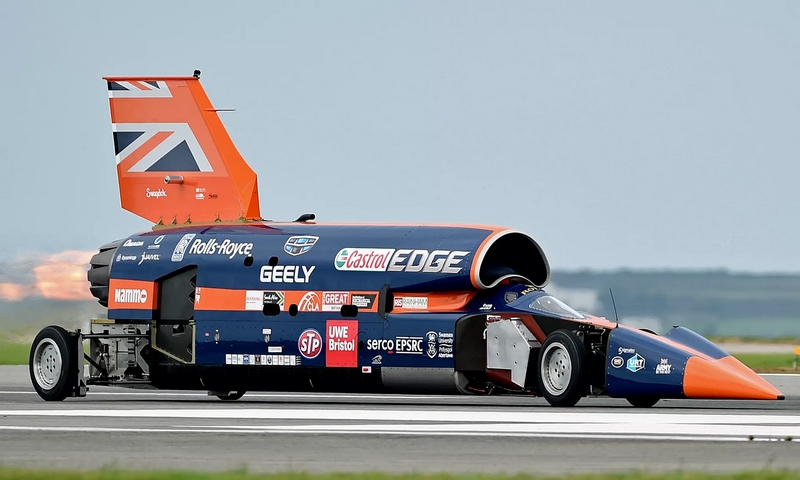
Bloodhound’s 1,000mph car project given financial boost; @Bloodhound SSC; bloodhoundeducation.com.
A British project to build a jet-powered car that will travel at more than 1,000mph is back on track under new ownership after being saved from the scrapyard at the last minute.
The Bloodhound scheme was just moments away from the end of the road when a Yorkshire businessman, Ian Warhurst, stepped in to provide the finances to keep the jet car in one piece.
At the relaunch of the project on Thursday, Warhurst said he thought briefly about consigning Bloodhound, which looks a little like a cross between a space rocket and a racing car, to a museum so it could be kept together.
But he decided that it was still possible to get the car ready to attempt the world land speed record of 763.035mph.
If successful, the team will attempt to get the machine past the 1,000mph mark, a challenge that has been compared with the first ascent of Mount Everest or flying to the moon.
The new home for the project is a workshop measuring almost 1,000 sq metres at SGS Berkeley Green University Technical College (UTC) on the banks of the river Severn in Gloucestershire.
Warhurst, who until recently ran a company that supplies turbochargers and parts, said he was saddened to hear that the previous company behind Bloodhound had gone into administration.
He said: “I took my own kids to visit it once and saw them being inspired. Last year I got a text saying it was up for sale and could be broken up. It seemed wrong. It was unbelievable to think it could become scrap.”
Warhurst arranged to see the administrators. “They delayed the break-up for me to look at the car. I knew that if I left that building and didn’t make a deal, that was the end. I couldn’t let that happen.”
He bought the car and contemplated placing it in a museum, which would have at least kept it in one piece. But then he decided to try to run it.
Now the plan is to work towards breaking the world land speed record to assess how the car behaves at transonic and supersonic speeds.
Dates for high-speed test runs and the world land speed record runs on a desert track in South Africa will be announced once operational and logistics planning is complete.
Bloodhound has already been 12 years in the making. Warhurst, now the CEO of a new company called Grafton LSR Ltd set up to run the project, said: “An incredible amount of hard graft has been invested and it would be a tragedy to see it go to waste.
“The reality is a lot of the issues we’re facing are unknown. You have to do one step at a time, first high-speed testing, then data to decide what we’re doing next.
“We are moving into the realm of the unknown. that’s what’s really exciting. Nobody has had a vehicle on the ground at these speeds before, the issues you get with shockwaves and loading on the car are beyond what’s known.”
The team says the next phase of the Bloodhound LSR project will be funded through sponsorship and partnerships, with cashflow provided by Warhurst. He is confident the project is commercially viable.
The idea is also to inspire a new generation of engineers. The executive principle of SGS Berkeley Green UTC, Kevin Hamblin, said: “To have such a groundbreaking engineering project on site which shares our philosophy to enthuse and encourage the next generation of engineers, designers and scientists, will be invaluable for our own students and also for thousands of young people across the region.”
Many members of the team that got Bloodhound to this point are still on board, including the former RAF fighter pilot and current world land speed record holder, Andy Green, who will drive the car.
Green speaks passionately about the project, explaining that it is about pushing back the laws of physics, as well as an adventure. He says the best way of illustrating how fast it may go is to imagine it travelling the length of a football pitch. If a spectator blinked, he or she would not see the car driving past.
“We are really excited to be in our new location, our new workshop, newly liveried car with a new owner,” Green said. “As soon as we can get all the paperwork sorted out to go to South Africa, as soon as we can get this car ready we’re off to do some high speed running.”
guardian.co.uk © Guardian News & Media Limited 2010
Published via the Guardian News Feed plugin for WordPress.

